A Complete Guide to Ruby Jewelry
Everything you need to know about Rubies' price, color and cut
Everything you need to know about Rubies' price, color and cut
Rubies, one of the four precious gemstones alongside diamonds, emeralds, and sapphires, are highly valued for their striking red color and remarkable durability. Originating mainly from countries like Myanmar, Thailand, and Sri Lanka, rubies are composed of the mineral corundum, the same mineral that forms sapphires. The most coveted rubies possess a rich, vivid red color often described as “pigeon’s blood,” and their value increases based on factors such as color intensity, clarity, cut, and carat weight.
As for budget, rubies can range from relatively affordable to extremely expensive, depending on their quality. Lower-grade rubies may cost as little as $100 to $300 per carat, whereas high-quality stones can command prices of $1,000 per carat or more, reaching up to $15,000 for particularly fine specimens. Rubies are most commonly used in various types of jewelry like rings, necklaces, and earrings, often serving as the centerpiece of the design due to their eye-catching hue. Whether you’re considering a ruby for an engagement ring or a special gift, its allure and symbolism of love and passion make it a timeless choice.
What is a ruby?
Are rubies more expensive than diamonds?
What are the ruby quality grading factors?
What are the types of rubies?
Rubies vs. diamonds
Rubies vs. sapphires
Lab-created rubies vs. natural rubies
How to tell if a ruby is real
Best place to buy rubies
Why you should trust us
Bottom Line Recommendation:
Like other gemstones, rubies are becoming an increasingly popular choice for engagement rings and other jewelry. With its bold color and striking looks, a ruby can be an eye-catching alternative to a more conventional diamond as a ring’s center stone.
Although buying a ruby isn’t quite as complicated as buying a diamond, there are still several factors that you’ll want to pay attention to. We’ve covered these below, with a range of elegant ruby engagement rings and other jewelry to serve as inspiration.
As always, the vendor you choose for ruby jewelry will have the biggest impact on pricing and value for money. We recommend buying from James Allen thanks to their extensive inventory, excellent photos, reliable certification and competitive pricing.
Blue Nile also have a range of pre-set ruby engagement rings and other ruby jewelry. However, their selection is significantly smaller than James Allen’s.
Angara is a specialist in gemstones and offer four different qualities of gems in a few different carat weight. This way, you can samewhat create your own version of any jewelry they offer.
If you’re specifically looking for extremely high-quality rubies that have not been heat-treated, you’ll want to look at Leibish & Co.’s selection. They stock a diverse selection of outstanding rubies graded by GIA and GRS (a Swiss lab that specializes in high-end, untreated rubies).
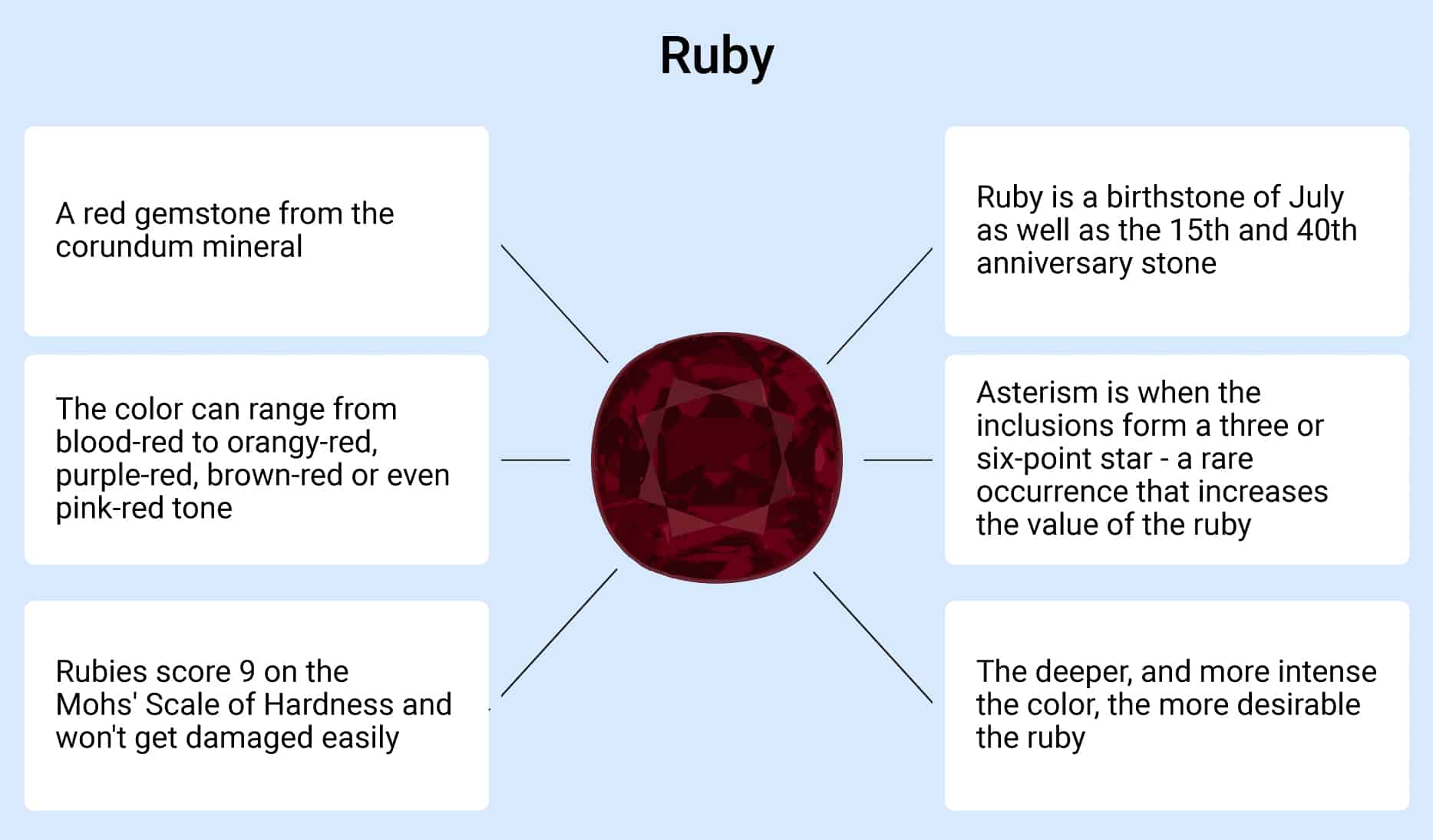
Rubies are red gemstones that consist in the corundum family. Most rubies have a strong red color, although the precise color of rubies can range from blood-red to orangy-red, purple-red, brown-red or even a pink-red tone.
With renewed interest in colored gemstones taking center stage lately, we’re going to take a closer look at one of the most romantic of all of the precious gemstones, the darling red ruby.
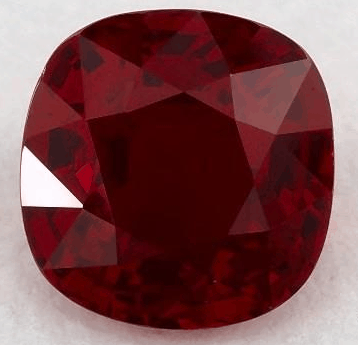
Rubies are made from corundum, a crystalline form of aluminum oxide. The ruby’s red color comes from trace amounts of the element chromium, which replace aluminum in the mineral and change its color.
When corundum is red, we call it ruby. When it’s any other color, such as blue, yellow, or pink, we call it sapphire. You can identify a ruby alongside other gemstones thanks to its rich, pink to blood-red coloration.
Ruby is said to be one of the rarest of the big three — rubies, sapphires, and emeralds. It’s the birthstone for July, as well as the 15th and 40th anniversary stone.
As with other gemstones, rubies are mined around the world for use in jewelry. Rubies can be found in the following countries:
Australia, Sri Lanka, Thailand, Myanmar, Cambodia, Vietnam, Japan, India, Pakistan, Afghanistan, Colombia, Namibia, Mozambique, Madagascar, Kenya, Tajikistan, Tanzania, Brazil, Scotland, United States
Rubies have a hardness of 9 on the Mohs’ scale, making them hard gemstones. In fact, they only fall behind the diamond, which scores a perfect 10.
This bodes well for wearing ruby jewelry every day — thanks to its hardness, you can wear a ruby ring, pendant or a pair of ruby earrings, like these ruby studs, with no need to worry about damaging the stone.
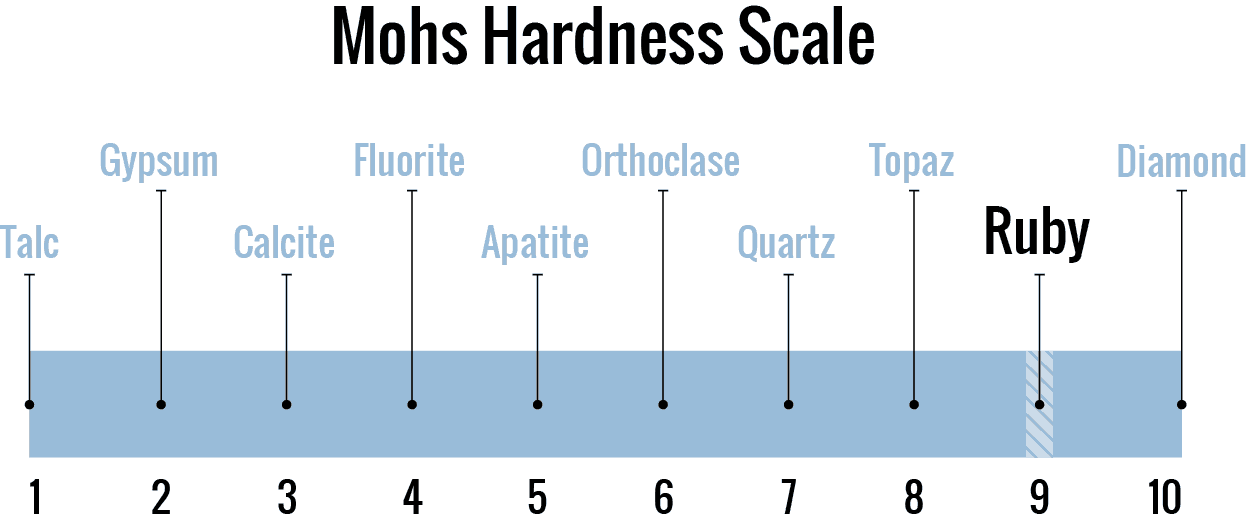
Historically, ruby jewelry has usually been given as anniversary and birthday gifts. For example, ruby studs, earrings and necklaces, such as this simple, yet beautiful round ruby pendant from Angara, are traditional gifts for people born in July, as we’ve covered in our guide to July birthstone gifts.
Ruby jewelry is also a popular gift for 15th and 40th wedding anniversaries. As we explained in our guide to anniversary rings, gifting a pair of ruby earrings or a ruby eternity ring is a great way to symbolize your love and affection for your partner.
Over the last decade, rubies have also become popular as engagement ring center stones. It’s now increasingly common to see ruby engagement rings instead of the traditional diamond, as well as rings that combine a large ruby with a diamond halo or pavé setting.
To see some examples of what a ruby looks like in engagement rings, visit our list of recently purchased rings from our highest-rated retailers.
If you’re considering buying a ruby to be set in a ring, earrings, pendant, or other jewelry, then it’s important to be aware of the key factors that go into a ruby’s appearance, beauty and value as a gemstone. Below, we’ve covered the basics of how to buy the best ruby for your money, covering the four Cs — color, clarity, cut and carat weight — as well as other common questions related to buying ruby jewelry.
Although some rubies are incredibly valuable and can command very high prices, most rubies are considerably less expensive than diamonds of the same size.
This lower pricing makes a ruby an appealing alternative to a diamond for an engagement ring or other jewelry. For example, this 1.25 carat ruby from James Allen only costs $820, whereas a diamond of the same size and reasonable quality, such as this one, costs more than five times as much.
Very high-end rubies can be far more expensive — in some cases, either as expensive or more expensive than diamonds of the same size. For example, this stunning Pigeon Blood ruby from Mozambique from Leibish & Co. costs more than $95,000.
Like diamonds, rubies are assessed using certain quality factors. Of these, the most important, by far, is color. High-quality rubies have a rich, deep natural color that hasn’t been changed by heat treatment. The stronger and more intense the color, the more valuable the ruby.
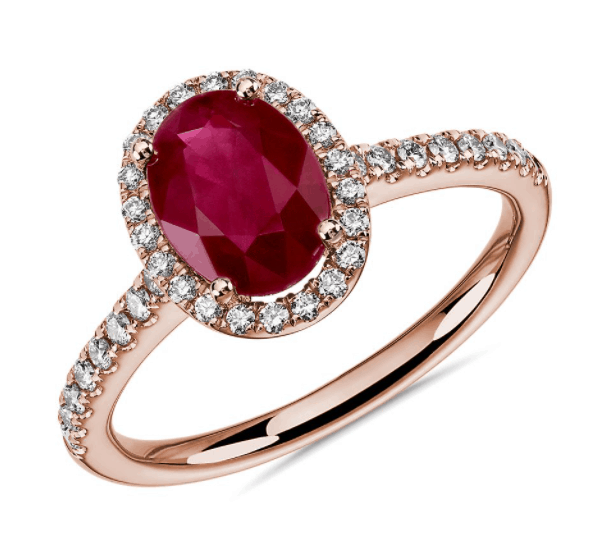
Other factors, such as clarity and cut quality, also play a role in a ruby’s value. However, since rubies aren’t prized for their brilliance like diamonds are, the cut quality of a ruby isn’t such a major factor in determining its beauty or value.
Finally, like with all gemstones, the carat weight of a ruby plays a role in its value, with a larger ruby commanding a higher value than a smaller one.
An exceptionally high-quality ruby that combines rich, natural color with other quality factors is exceptionally rare and often worth an incredible amount. For example, this stunning 10.6 carat Pigeon Blood ruby from Mozambique from Leibish & Co. is priced at more than $850,000.
However, good quality rubies don’t necessarily need to cost a fortune. As we mentioned above, it’s very possible to buy a gorgeous ruby for a significantly lower price than a diamond of similar carat weight.
We’ve covered each of the quality factors listed above in more detail below, with information on how each affects a ruby’s beauty and value. We’ve also provided our tips on choosing the right ruby and ensuring you pay a fair price.
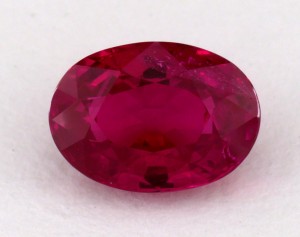
As with emeralds, the most important factor when evaluating a ruby is its color. The deeper, and more intense the color, the more desirable the ruby. The best ruby color is typically thought of as a deep, vivid red. However, rubies can look stunning in other colors, such as pink or brown-red.
Essentially, we measure the color of a ruby using three criteria: its hue, tone and saturation.
Hue refers to where the ruby falls in the spectrum of other colors. Each ruby has a primary and secondary color. The primary color is red, and the secondary color is usually orange, purple or pink. The more the ruby’s color is strictly red, the more valuable it is.
Some rubies mined from specific parts of the world are known to have certain secondary colors, such as rubies from Myanmar, which are known to have a slight purple secondary color.
Purple as a secondary color can actually be better in a ruby because it makes the red appear richer. (Color tip: set a purplish red ruby in yellow gold, like they do in Burma. The yellow color will neutralize the blue in the purple, making the ruby appear even more red.)
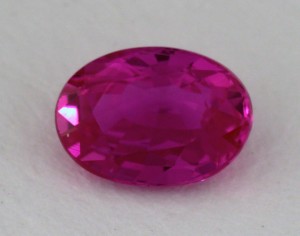
The tone of a ruby’s color refers to how light or dark the shade of red is, with most good quality rubies falling somewhere between medium and medium dark tone. If a ruby’s color is too dark, it’s difficult to make out the color. If it’s too light, the color will be too faint.
Also, if a ruby’s tone is too light, it might be considered a pink sapphire — even if the stone has high saturation.
This brings us to our last color criterion, saturation. Saturation refers to the ruby’s depth of color, or how intense the color is. The more intense the color, the more precious we consider the ruby; a well-saturated ruby will most likely have either “strong” or “vivid” color saturation.
Also, rubies that fluoresce (glow in ultraviolet light) can have even greater saturation. And rutile needles, which are tiny inclusions, could improve the ruby’s color by reflecting light from inside the stone.
It should go without saying that if the color of a ruby is by far the most important factor, it would be crazy to even consider buying a ruby sight unseen. This is why we recommend buying ruby jewelry online from James Allen, as their high-resolution photos let you accurately view a ruby’s color before you make a purchase.
Unlike diamonds, which are graded according to a strict system of letters starting with “D” and going on through the alphabet, colored gemstones such as rubies aren’t graded using any kind of objective system.
Instead, gemological laboratories use master stones in order to contrast colored gemstones to other stones’ hues, tones, and saturations.
This is the only way, for example, that gemologists can distinguish between pink sapphires and rubies. But it also leaves some room for error, so beware of these murky waters if someone is trying to sell you a ruby that looks a lot more to you like a pink sapphire!
Clarity refers to the number, size, color, location, and quality of imperfections in the ruby, which are known as inclusions. When a gemologist measures the clarity of a diamond, they use 10x magnification to get a super-magnified view of the inside of the stone.
With colored gemstones, however, gemologists do not use magnification; rather, they look for what we call “eye-cleanliness,” which means that the stone is clean or free of inclusions when viewed by the naked eye. The better the clarity, the more expensive the ruby.
All natural rubies will contain some level of inclusions, also known as rutile needles or “silk.” If there are no visible rutile needles in a ruby, gemologists will suspect the ruby has been treated or is synthetic.
Today most rubies are heat-treated to improve color and clarity, but rubies that are not and have superb quality can fetch big money at market. For example, Leibish & Co.’s selection of rubies is made up entirely of natural, untreated rubies, with pricing to match.
Interestingly enough, there is one example of inclusions actually increasing the value of the ruby.
This is a rare occurrence called asterism in which three or six-point stars are visible in the stone when viewed under proper lighting.
This happens when light is reflected off the rutile needles, thus creating the star effect.
A ruby’s cut refers to how the stone is faceted, its dimensions, and overall symmetry. Unlike with diamonds, rubies are not graded on cut quality. This is because the cut of a ruby is much less of an important factor to consider than its color and clarity.
But as is the case with most gemstones, the true glow of the ruby is only revealed after a quality cut that maximizes light return and color. There are four factors gem cutters must keep in mind when cutting sapphires and rubies.
Finally, let’s consider the ruby’s carat weight. As you’ve probably already guessed, the heavier the carat weight of the ruby, the bigger the price tag. Because larger gemstones are rarer than smaller gemstones, you’ll pay more for a larger ruby based on the laws of supply and demand.
Having said that, you should also be aware that there are usually price jumps when you hit one carat, as well as three and five carats. If you want to buy a one carat ruby, consider going for a 0.9 ct. Instead. While you won’t notice the difference in the size of the stone once it’s set, you’ll definitely notice the savings in your wallet.
Rubies come from all around the world and are available in a range of different shapes and red shades. However, most rubies are categorized into certain types based on the country or region from which they’re mined. Common types include:
Like diamonds, rubies are cut into a variety of shapes. While the round brilliant cut is the most common shape for diamonds, rubies are typically shaped based on the formation of the stone rather than as a method of maximizing brilliance and fire.
Because of this, it’s more common to see rubies in non-round shapes, such as the oval, pear and marquise cuts. Like with all gemstones, there’s no “best” shape for a ruby — instead, you should choose a shape that looks the most beautiful to you personally.
Rubies are increasingly becoming an alternative to diamonds for engagement rings and other jewelry. Differences between rubies and diamonds include:
Rubies and sapphires are both varieties of the mineral corundum and share a large amount of the same chemistry. Both score 9 on the Mohs’ scale of hardness, making them highly durable gemstones that can safely be worn every day.
The key difference between rubies and sapphires is chemistry and color. Rubies contain trace amounts of the element chromium, which gives the stone its red color. Sapphires may contain several different trace elements that contribute to their color.
Just like diamonds, rubies can be created in a lab. Natural rubies are formed under the earth’s crust over the course of 20 million years, whereas lab-created rubies are synthesized in a controlled setting in a laboratory.
Lab-created rubies tend to be much cheaper than natural rubies. They also tend to be produced without the flaws that are present in natural rubies. From a chemistry perspective, a lab-created ruby is the same mineral as a natural one, with identical chemical properties to a natural stone.
To some people, lab-created rubies look slightly too “perfect” and devoid of the natural beauty and character that’s present in an earth-created gemstone. To others, the lack of flaws may be an advantage.
Appearance is subjective, and both lab-created and natural rubies can look beautiful. Ultimately, the best choice is the one that most closely matches your tastes and budget.
Because of their rarity, rubies are often faked. We recommend buying only from a trusted ruby jewelry vendor such as James Allen to avoid buying fake rubies. To tell a fake ruby from a real one, you can use the following techniques:
Note that a lab-created ruby is not the same as a fake ruby. Lab-created rubies are chemically identical to natural ones, although their appearance may be slightly different upon a very close examination (for example, few or unnatural-looking inclusions).
Fake rubies, on the other hand, are typically made from materials such as glass, or from other, cheaper gemstones. These are chemically different from rubies and won’t have the same level of strength or a similar appearance.
As we mentioned above, we recommend James Allen if you’re looking to purchase loose rubies or ruby jewelry online. We make this recommendation for several reasons:
In short, everything that works in their favor regarding diamonds is true here as well. There are also a few specific tips that you’ll want to keep in mind if you’re purchasing a ruby engagement ring, which we’ve covered below.
As we mentioned earlier, Leibish & Co. is also a good option if you specifically want a ruby that hasn’t been heat treated. Their selection of rubies includes lots of outstanding stones, although the pricing is significantly higher than James Allen’s selection of heat treated rubies.
As we mentioned earlier, ruby engagement rings are becoming increasingly popular for several reasons:
In general, buying a ruby engagement ring is a fairly simple process. Since clarity isn’t as much of a factor as it is with a diamond, you don’t need to worry too much about inclusions. You can also get a good idea of a ruby’s color just from looking at it in large, well-lit photos.
Still, there are a few things you’ll want to keep in mind when you’re viewing ruby engagement rings online or creating your own using a loose ruby and setting.
Rubies can look fantastic in a variety of settings, from white gold and platinum to yellow or rose gold. However, the type of metal you choose for your setting — and more specifically, the metal’s color — will play a role in how the ruby engagement ring looks as a whole.
Thanks to their lighter color, white gold and platinum have more contrast with the rich red color of a ruby. This makes them both good options if you want the color of the ruby to stand out and attract attention. These metals both complement fair or rosy skin tones very nicely.
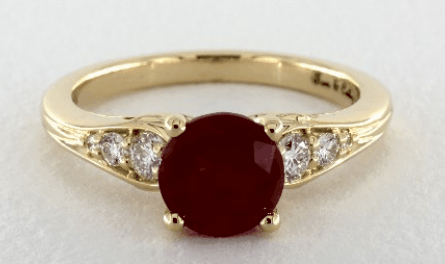
White gold and platinum look almost identical to the naked eye, with very little visual difference between the two metals.
Yellow and rose gold are both good choices if you’re looking for an engagement ring that has a warm look. Both of these metals complement ruby beautifully, making them good options if you want a ruby engagement ring with more of a warm, vintage feel.
Rubies can look fantastic in a variety of settings, from simple solitaire settings such as this one from James Allen to more ortane pavé settings like this one. Like other colored gemstones, they also look great in halo settings, which emphasize the rich color of the ruby center stone.
For example, this ruby engagement ring from Blue Nile has an impressive halo setting that attracts attention to the beautiful center stone, all while giving the ring an elegant, classic appearance.
Just like with a diamond engagement ring, there’s no best setting for everyone. Pick a setting that fits within your budget while matching your fiancé-to-be’s tastes and the two of you will be able to enjoy a stylish, timeless ring that’s truly special.
Shop for ruby engagement rings here.
If you need more help buying a ruby engagement ring or any other ruby jewelry, please contact us. Our experts can help you find the highest quality ruby jewelry for your budget.




Before you buy a diamond, get personal buying advice from industry veterans. We'll help you get the best diamond for the money.
DISCLAIMER: We don't use your email for marketing. Period.
A diamonds’ price is determined primarily by the 4 Cs of the diamond. On the wholesale level, diamond prices are first based on a diamond shape and
Buying an engagement ring is often one of the first major purchases in a person's life. The process can be fraught with tension as there are so m
A wide range of 1 carat diamonds exist both in online markets and local diamond jewelry stores. Not only are there significant differences in beauty
Please enter your email address to receive your 25% off coupon code:
Here is your coupon code: GFDSF3GF